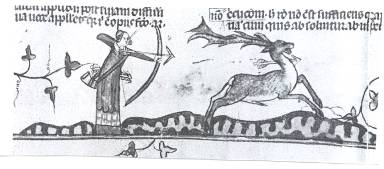The Legend 4
Robyn and Gandelyn survived in a manuscript collection of the mid-fifteenth century. It begins with Robyn and Gandelyn going to the woods to hunt deer. They find a herd, Robyn shoots the fattest deer then is himself shot and killed. The assassin turns out to be Wrennok of Donne. After verbal interaction Wrennok shoots at Gandelyn and misses; Gandelyn in reply shoots Wrennok through the heart. There may be some connection with Robyn and Gandelyn, to the earlier Tale of Gamelyn that was composed in about 1350. In this anonymous poem, Gamelyn is cheated out of his inheritance by his brother John, consequently he flees into the forest to become an outlaw. John becomes sheriff and tries to capture his brother. The Tale of Gamelyn is similar to the later Robin Hood story. Gamelyn is a disinherited nobleman who is cheated by his family, he becomes an outlaw, his main adversary is the sheriff, and the king pardons him.
Robin has little regard for authority (apart from the king) his enemies in the Gest include Bishops and Archbishops and the sheriff of Nottingham. The ballads do not explain why he became an outlaw, and his animosity towards the sheriff is taken for granted, although some believe the story of the sheriff of Nottingham may have originally been separate, and later joined with the legend of Robin Hood. In the Gest Robin says: ‘If he be a pore man of my good he shall have some’, this theme would appeal to the common man, but Robin does not rob from the rich to give to the poor. He gives a loan of four hundred pound to a knight who is in debt to the abbot of St Mary’s York, but later takes eight hundred pound from two monks of the same abbey. When the knight returns to repay his debt, Robin gives him another 400 pound above the initial loan then keeps the rest. The ballads do not show us a real Robin Hood, whose origins are lost in time.
Robin had ‘Seven score of wyght yonge men’, but only Little John, Much the Miller’s Son, William Scathelock, Gilbert with the White Hand, and Reynold, were given a name. Friar Tuck is not mentioned in the early ballads, however a play about Robin Hood does include him as a member of Robin’s band. The play was written around 1475, but all that remains is a fragment of twenty-one lines, and this is now known as the Dramatic Fragment. It has some similarity to part of the story told in Robin Hood and Guy of Gisborne. Two royal writs of 1417 record that a man called Friar Tuck had committed murders and robberies with a band of men. This occurred in Sussex and Surrey, and by 1429 his real name had been revealed, he was Robert Stafford a chaplain of Lindfiels Sussex. It is possible that Robert Stafford was the original Friar Tuck.


|
